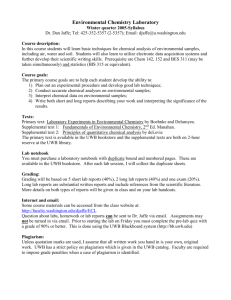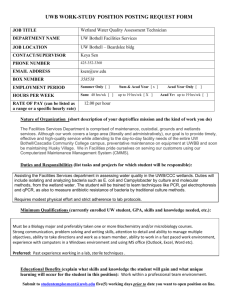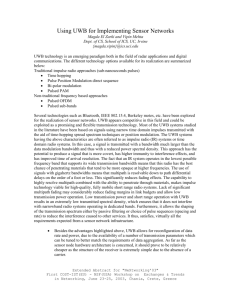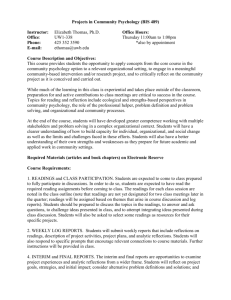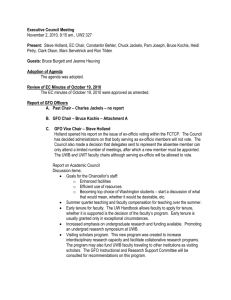APT/AWG/REP-01 (Rev.1) - Asia
advertisement
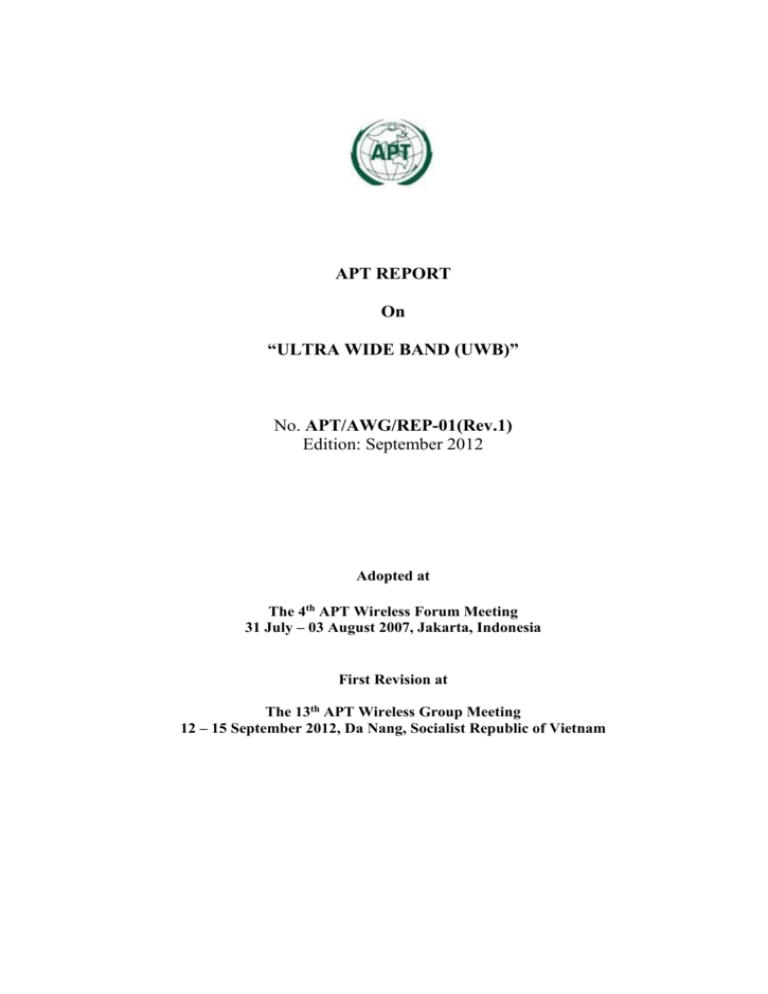
APT REPORT On “ULTRA WIDE BAND (UWB)” No. APT/AWG/REP-01(Rev.1) Edition: September 2012 Adopted at The 4th APT Wireless Forum Meeting 31 July – 03 August 2007, Jakarta, Indonesia First Revision at The 13th APT Wireless Group Meeting 12 – 15 September 2012, Da Nang, Socialist Republic of Vietnam APT/AWG/REP-01(Rev.1) ASIA-PACIFIC TELECOMMUNITY The APT Wireless Group Source: AWG-13/OUT-09 APT REPORT ON ULTRA-WIDEBAND (UWB) TABLE OF CONTENTS 1. INTRODUCTION……………………..………………………………………………………………………………...1 1.1 Commercial UWB products……………………………..……….…………………………..……………….1 1.2 Regulatory Activities in APT Countries…………..……………….………..………………………….1 2. UWB APPLICATIONS………………………………………………………………………………………………2 2.1 UWB Communications Systems……………………………………………………...……………………2 2.2 UWB Imaging Systems………………………………………….………………………...……………………2 2.3 UWB Automotive Radar……………………………..…………………………………...……………………2 3. UWB REGULATORY DEVELOPMENTS…………………………..……………...……………………3 3.1 Federal Communications Commission (FCC) ……………………………...………………………3 3.2 Electronic Communication Committee (ECC) ………………………………...………………...…3 3.3 International Telecommunication Union (ITU) …………………………….………………………5 4. CONCLUSION……………………………………………..……………………………………..………………………7 5. REFERENCES……………..……….……………………………………………………………..………………………8 6. ANNEXES…………………………….…..……..…………………………………………………….………...………….9 Annex A: Japan’s UWB Emission Mask ………………….………………...……………………...…….…9 Annex B: Korea’s UWB Emission Mask ………………………………….………...………………….…10 Annex C: FCC’s UWB Emission Mask ………………………….…………….…..………………………11 Annex D: Europe’s UWB Emission Mask …..…………………………….…….…..……………………12 Annex E: UWB Regulatory Framework in APT ………………………………………………………13 Page 2 of 17 APT/AWG/REP-01(Rev.1) 1 INTRODUCTION Traditional radio systems use dedicated frequency spectrum for sending and receiving radio signals in order to mitigate interference effects. Contrary to this approach, Ultra-Wideband (UWB) technology, as its name suggests, operates by spreading its radio signals across a very large frequency band (typical bandwidth > 500 MHz). UWB transmissions will usually be lowpower and will operate in frequency bands already allocated to other radio-communication (e.g. satellite services, microwave links and radiolocation), including those licensed exclusively to commercial entities for their use (e.g. cellular mobile operators and wireless broadband access operators). As a result of this fundamental difference, UWB is likely to affect how the frequency spectrum is managed. 1.1 Commercial UWB Products Commercial UWB products are expected to be widely available within the next few years. In fact, a new four-port UWB hub that supports higher data transfer than existing Bluetooth and USB 2.0 technology was launched in Japan on November 2006. More importantly, it is touted as a seamless replacement for wired USB connection to peripheral devices. In December 2006, Korea’s SK Telecom and Staccato Communication announced their plans to introduce mobile handsets with UWB to enable better content delivery services. Wireless USB connectors, on the other hand, are expected to be readily available by end 2007. For the automotive industry, Mercedes Benz had launched its S-Series model in Europe using UWB technology for collision avoidance. 1.2 Regulatory Activities in APT Countries In Asia Pacific region, some APT member countries like Japan and Korea have implemented regulatory framework to permit unlicensed use of UWB devices in indoor environment, while others like Singapore and Hong Kong have established UWB trials within localised zones. In the case of Singapore, a UWB Friendly Zone (UFZ) is created in the Science Park II for UWB developers to conduct realistic field experiments. Hong Kong, on the other hand, allocates the 3.1-10.6 GHz band for UWB indoor trials and the 4.2-10.6 GHz band for outdoor trials. In Japan, the preliminary mask for UWB was announced back in September 2005. Subsequent compatibility studies show that UWB devices operating in the 3400-4200 MHz band should incorporate interference mitigation techniques. However, devices are allowed to operate in the 4200-4800 MHz band without mitigation techniques until end of December 2008. Other technical conditions are imposed for UWB radio systems operating in the 3.4 to 10.25 GHz band (see Annex A for Japan’s emission mask). For Korea, the spectrum allocation for UWB starts in the frequency band from 3.1 to 10.2 GHz. Considering the importance of harmful interference avoidance to IMT system and broadcasting relay system, in Korea, interference mitigation technology such as Detect and Avoid (DAA) technology shall be used for the UWB devices operating in the 3100 to 4200 MHz band from April 2007, and for those operating in the 4200 to 4800 MHz band from January 2017 (see Annex B for Korea’s emission mask). 2 UWB APPLICATIONS Page 3 of 17 APT/AWG/REP-01(Rev.1) In general, UWB devices can be broadly categorised into different types of UWB applications, according to its potential to cause interference to the existing radiocommunications services. UWB applications can be categorised into communications systems, imaging and vehicular radar while the ECC, at this stage, only considers the first two types, excluding vehicular radar. Accordingly, specific emission limits and operation guidelines can be designed to mitigate interference for each type of UWB application. 2.1 UWB Communications Systems Consumer UWB devices are generally categorised as being short-range UWB communications systems that will be used for high data rate wireless connections between computers, digital cameras, players, displays and various consumer products meant for the mass market. The primary advantage is low power consumption and thus provides longer battery life for portable devices. In future, it may replace existing USB cables, i.e. firewire, between portable multimedia consumer electronic devices or it may enable high-speed wireless universal serial bus (WUSB) connectivity for peripheral devices. It is noted that the FCC, Europe, Korea and Japan are aligned in having the entire or parts of the 3100 to 10600 MHz band for such pervasive applications. 2.2 UWB Imaging Systems The use of UWB imaging systems in the frequency bands below 960 MHz and 3.1GHz – 10.6 GHz has now expanded from military to public security and protection purposes. UWB radar systems can be used to detect people buried underground or behind walls after disasters or accidents. It is also commonly used in the construction and maintenance industry to detect and locate reinforcement bars, electric wiring and pipes inside concrete/walls. Nowadays, UWB imaging systems is being developed for innovative types of imaging systems for medical diagnostic and industrial use. 2.3 UWB Automotive Radar A global alliance of motor vehicle and electronics manufacturers has established an international standard known as Short-range Automotive Radar frequency Allocation (SARA). Its aim is to push forward the adoption and worldwide implementation of automotive collision avoidance radar systems for enhancing the safety of drivers and passengers. UWB automotive radarenabled vehicle is already available in some European countries, USA and Australia and is expected to be available in New Zealand very soon. In particular, Mercedes Benz had launched its S-Series model in Europe using UWB technology for collision avoidance. With regard to spectrum allocation, the FCC and ECC have opened up the 22-29 GHz (only until 2013 in the case of Europe) and 79 GHz bands for the operation of automotive short range radar. 3 UWB REGULATORY DEVELOPMENTS In April 2004, the Federal Communications Commission (FCC) announced its decision to permit the marketing and operation of certain products incorporated with UWB technology. Thus, the USA became the first country to allow the unlicensed commercial use of UWB devices. This initiative helps to spur worldwide regulatory developments of UWB, with some countries starting to conduct public consultation exercises for their respective UWB rules, as well as proposing emission masks based on modifications of the FCC’s UWB masks. Page 4 of 17 APT/AWG/REP-01(Rev.1) 3.1 Federal Communications Commission (FCC) In view of the unclear impacts cause by UWB devices, the FCC adopted a cautious approach in devising its standards in the First Report & Order (R&O) on UWB technology. FCC believes that the combination of technical standards and operational restrictions will help to ensure that UWB devices can coexist and give adequate protection to other radiocommunication services. In the First Report and Order [1], FCC concluded that low-power UWB devices indeed can operate within the existing spectrum without causing significant interference (it should be noted however, that FCC did not consider a 1 dB noise rise significant in this regard. They also assumed cellular services to have a higher level of received signal than is often the case in practice). Hence, FCC amended Part 15 of its rules to permit UWB operation without a license or the need for frequency coordination. However, for regulatory purposes, FCC established various technical standards and operating restrictions for 3 types of UWB devices: 1) communications systems; 2) imaging systems (including ground penetrating radars); and 3) vehicular radar systems. The classification for each type of UWB devices is based on their potential to causing interference to the existing licensed users in the 3.1-10.6 GHz frequency band. Accordingly, emission limits are designed for each type of UWB devices to further mitigate interference (details of emission limits are outlined in Annex C). In December 2004, FCC released its Second Report and Order and a Second Memorandum Opinion & Order on UWB [2] to provide greater flexibility for the introduction of widebandwidth devices and systems which do not fall into the classification of UWB technology. Under the new rules, the peak power limits for wide-bandwidth device emission is raised to the same level as UWB devices in the three frequency bands already made available for unlicensed operation, i.e. 5925-7250 MHz, 16.2-17.2 GHz and 23.12-29 GHz. In addition, the Commission amended its measurement procedures to permit frequency hopping, swept frequency, and gated systems operating in these bands to be measured in their normal operating mode. 3.2 Electronic Communication Committee (ECC) In comparison with the FCC rules and technical specification, the ECC recommendations appear to be more stringent and its decision on the emission limit in the 2.7-3.4 GHz band remains divided. Unlike the FCC which has 3 types of UWB devices, ECC only considers, at this stage, 2 main types of UWB systems that operate below 10.6 GHz: 1) UWB communications systems; and 2) UWB imaging systems. In February 2005, the Electronic Communications Committee (ECC) published a ECC Report 64 [3] that describes the general limits for UWB applications, in terms of maximum power spectral density (PSD), required to protect radiocommunication services below 10.6 GHz. While the report is largely based on theoretical analysis, the ECC report determines maximum generic UWB PSD values more stringent than those values illustrated in the FCC’s e.i.r.p density limits by 20-30 dB, reflecting the higher density of other devices in use or anticipated 2-5 GHz. The ECC highlighted that the assumptions used in the report are highly dependant on deployment parameters such as UWB device densities and activity factors, aggregate interference cases and protection distance requirement for single interference cases. Although the maximum UWB PSD limits will protect the existing services with a high degree of confidence, the ECC recognises that the regulatory solutions would not facilitate UWB operation in Europe. In March 2006, the ECC released its Decision [4] (amended in July 2007), in relation to the harmonised introduction of generic devices using UWB in bands 6-8.5 GHz. The Decision includes the exemption of individual licensing and that UWB devices are allowed to operate on Page 5 of 17 APT/AWG/REP-01(Rev.1) a non-interference and non-protection basis. However, the Decision does not apply to flying models, outdoor installations and infrastructure, including those with externally-mounted antennas and devices installed in road and rail vehicles, aircraft and other aviation. In addition, any UWB devices that are within the scope of the Decision are also not allowed to be used at fixed outdoor location or connected to a fixed outdoor antenna. The technical requirement for devices using UWB technology is outlined in Annex D. In December 2006, the ECC further approved 2 new Decisions [5], [6] and ECC Report 94 [7], in response to an EC mandate to CEPT to identify the conditions relating to the harmonised introduction of UWB devices in the European Union. Under the new approved Decisions, UWB devices implemented with Low Duty Cycle (LDC) are permitted to operate in the frequency band 3.4 to 4.8 GHz at -41.3 dBm/MHz; same level adopted by FCC. And in view of unproven mitigation techniques such as Detect and Avoid (DAA), the ECC will further investigate the effectiveness of DAA in protecting radars below 3.4 GHz. The other Decision approved by ECC is to address the issue of imaging applications (Ground-and Wall-Probing Radar) which did not fit within the generic UWB PSD limits made in the first ECC Decision in March 2006. As a result, ECC decided to use new emission limits for GPR/WPR applications and radio interface parameters for EU members to adopt. Also arising from the same ECC mandate, ECC Report 94 presents the LDC technical requirements for UWB devices in the 3.4 to 4.8 GHz to ensure protection of FWA systems. In determining the efficiency of the mitigation technique, ECC excluded the band 3.1 to 3.4 GHz in the report, to reflect the absence of Fixed Services (FS) and Mobile Services (MS) in the band. The ECC Report 94 concluded that sharing the frequency band with UWB devices implemented with LDC will result in minor impact on WiMAX services, unless adequate proximity distance is maintained between the two applications. In Feb 2007, the Europe Commission (EC) announced its Decision [8] to allow the use of spectrum by equipment using ultra-wide band technology and to harmonise the conditions throughout Europe. Also within six months of the announcement, the EC stipulated that the technical conditions in the Decision must be applied throughout the European Union's 27 Member States. As for equipment operating in the 4.2-4.8 GHz band without mitigation technique, the EC decided that such equipment replace by more restrictive conditions beyond the date of 31 December 2010. 3.3 International Telecommunication Union (ITU) As resolved at the ITU, UWB devices should not cause harmful interference to a radiocommunication service and shall not claim protection from interference to which they may be subjected. In other words, UWB devices are expected to operate on a non-interference and non-protection basis. The ITU, however, is unable to concur on a common emission mask (a set of maximum power limits for UWB to operate in the different frequency bands). ITU has completed its work on the UWB framework which should be used as a guide by administrations when considering the introduction of devices using UWB technology. While the recommended framework aims to protect the existing radiocommunication services from interference, it is not intended to hinder the development of devices using UWB technology. In this regard, the administrations will have to make their own analysis on mitigation factors and parameter sets that is most suitable for their respective situations. A brief description of the Recommendations is as follows: Page 6 of 17 APT/AWG/REP-01(Rev.1) a. ITU-R SM.1754 [9] recommends measurement techniques for generating UWB signals with various modulation and randomisation schemes. This document includes both frequency domain and time domain measurement techniques of the PSD of UWB transmissions for all UWB signal types; b. ITU-R SM.1755 [10] recommends the general characteristics of UWB technology; c. ITU-R SM.1756 [11] recommends the framework and provides guidance to administrations considering the introduction of devices using UWB technology; and d. ITU-R SM.1757 [12] recommends methodologies which assess the impact of UWB devices on systems operating in the spectrum band concerned. It includes a summary of both theoretical analyses and measurement studies carried out in the laboratory and in the field. In developing a national framework for UWB, ITU-R SM.1756 put forward 2 possible implementations: 1) a generalised regulatory; and 2) an application-dependent regulatory. For the generalised regulatory implementation, the administrations may consider imposing usage restrictions, technical limits and controls (i.e. activity factors and UWB power spectral density), and mitigation techniques to address interference concerns. For application-dependent regulatory implementation, the approach is to restrict the use of certain UWB devices (i.e. imaging devices and automotive short-range radar) in certain premises and allow specific group of people to operate these devices. The recommendation from ITU-R SM.1757 outlines a summary of studies in relation to the impact of devices using UWB on radiocommunication services. The emphasis is to evaluate the permissible UWB EIRP density in order to ensure proper protection of existing radiocommunication services operating within the frequency band. ITU-R TG 1/8 proposes three general categories of victim receivers, as listed in Table 1. Category Designation Victim Service/Application Dominant Interference Scenarios A Mobile and portable stations Single-entry interference B Fixed outdoor stations - Mobile handset (GSM, DCS1800, IMT-2000, MSS, RNSS), - Portable broadcasting receiver (ATSC-DTV, T-DAB, DVB-T, Analogue TV, Digital FM, ISDB-T, ISDB-TSB), - RLAN, Indoor FWA - FS station (P-P, P-M-P) - Base station from the mobile service - Radio astronomy station - Earth station (FSS, MSS) - Broadcasting fixed outdoor receiver Aggregate interference from surrounding UWB Single-entry interference Page 7 of 17 APT/AWG/REP-01(Rev.1) - Radar station C Satellite/aeronautical - Satellite receiver (EESS, on-board receivers MSS, FSS) - Aircraft stations Aggregate interference from large scale area Table 1: Categories of Victim Receivers Table 1 shows the impact on the different categories of victim receivers from single device and the aggregate effects from multiple UWB devices in different pre-defined deployment scenarios. The objective of the study is to provide a guideline for administrations on the maximum EIRP density and separation distance that should be observed for each category of victim receivers. 4 CONCLUSION In view of the UWB product and regulatory developments, APT members should actively prepare for pervasive use of UWB devices and formulate a regulatory framework to manage the risk of interference from UWB devices to the existing radiocommunication services. The ITU recommends that Administrations consider a regulatory framework with minimal administrative procedures, technical specifications and national regulations, which still provides the regulation and mitigation necessary to protect existing services. The USA, Europe, Korea and Japan have already adopted a regulatory approach of allowing licence-exempt or class licence operation of UWB devices. Whilst some countries have restricted the use of unlicensed UWB devices to indoor environment, it is possible that such restrictions are likely to be relaxed in future when mitigation techniques are proven to be effective in reducing interference. In this regard, APT members may introduce operating restrictions based on individual regulatory requirements and use Annex E to assist in formulating a UWB regulatory framework. To date, there is very little published data on the impact of actual UWB devices on existing services and vice versa. Since there are field trials and experiments taking place in the Asia Pacific region, APT members are urged to provide their findings to the AWF. This information would provide APT members with additional direction in choosing an appropriate regulatory framework for UWB devices. Going forward, it is suggested that APT members look into harmonising the UWB regulatory framework using the following guidelines: a. To allow deployment of UWB devices in parts of the bands below 10.6 GHz while ensuring protection of existing and planned stations of radiocommunication services; b. To adopt licence-exempt or class licensing approach for operating UWB devices; c. To license UWB Imaging devices on a case-by-case basis; d. To cap the maximum power spectral density at -41.3 dBm/MHz for licenceexempt or class licence devices - whilst incorporating notching requirements to ensure protection of existing and planned stations in the allocated bands; and Page 8 of 17 APT/AWG/REP-01(Rev.1) e. To consider implementing other mitigation techniques to protect the existing radiocommunication services. 5 REFERENCES [1] FCC 02-48, “Revision of Part 15 of the Commission’s Rule Regarding Ultra-Wideband Transmission Systems”, First Report and Order, ET 98-153; adopted: February 14, 2002; released: April 22, 2002. [2] FCC 04-285, “Revision of Part 15 of the Commission’s Rule Regarding Ultra-Wideband Transmission Systems”, Second Report and Order and Second Memorandum Opinion and Order, ET 98-153; adopted: December 15, 2004; released: December 16, 2004. [3] ECC Report 64, “The Protection Requirements of Radio-Communications Systems Below 10.6 GHz from Generic UWB Applications” by Helsinki, February 2005. [4] ECC/DEC/(06)04, “ECC Decision of 24 March 2006 amended 6 July 2007 at Constanta on the harmonised conditions for devices using Ultra-Wideband (UWB) technology in bands below 10.6 GHz”, released: March 2006 and amended 6 July 207. [5] ECC/DEC/(06)08, “ECC Decision of 01 December 2006 on the conditions for use of Ground-and Wall Probing Radar (GPR/WPR) imaging systems”, released: December 2006. [6] ECC/DEC/(06)12, “ECC Decision of 01 December 2006 on the harmonised conditions for devices using Ultra-Wideband (UWB) technology with Low Duty Cycle (LDC) in the frequency band 3.4 – 4.8 GHz”, released: December 2006. [7] ECC Report 94, “The technical requirements for UWB LDC devices to ensure the protection of FWA systems”, by Nicosia, December 2006. [8] Commission Decision 2007/131/EC on allowing the use of the radio spectrum for equipment using ultra-wideband technology in a harmonised manner in the Community, released: February, 2007. [9] Recommendation ITU-R SM.1754,” Measurement techniques of ultra-wideband transmissions”. [10] Recommendation ITU-R SM. 1755,” Characteristics of ultra-wideband technology”. [11] Recommendation ITU-R SM. 1756,” Framework for the introduction of devices using ultra-wideband technology”. [12] Recommendation ITU-R SM. 1757,” Impact of devices using ultra-wideband technology on systems operating within radiocommunication services”. [13] AWF3/14, “Technical Conditions on UWB Radio Systems in Japan”, by MIC, Japan. Page 9 of 17 APT/AWG/REP-01(Rev.1) [14] AWF3/23, “Proposed Working Document Toward Preliminary Draft Recommendation APT [UWB] Spectrum Use For Ultra Wideband (UWB) Technology”, by Republic of Korea. [15] AWF4/INP-23, “Proposed Modification of Draft AWF Report on Ultra-Wideband (UWB)”, by Republic of Korea. Page 10 of 17 APT/AWG/REP-01(Rev.1) Annex A: Japan’s UWB Emission Mask Japan Emission Mask 3.4 -40 4.8 7.25 10.25 Power Spectral Density (dBm/MHz) -45 -50 -55 -60 -65 2.7 10.6 11.7 -70 Japan -75 -80 1.6 -85 -90 1 2 3 4 5 6 7 8 9 10 11 12 Frequency (GHz) Note: For devices not equipped with any interference mitigation techniques, the average power shall be -70 dBm/MHz and the peak power shall be -64 dBm/MHz in the 3400 – 4800 MHz Band [13]. However, devices are allowed to be used without any interference mitigation techniques in the 4200-4800 MHz band until the end of December 2008. Page 11 of 17 APT/AWG/REP-01(Rev.1) Annex B: Korea’s UWB Emission Mask Korea Emission Mask 3.1 -40 4.8 7.2 10.2 Power Spectral Density (dBm/MHz) -45 -50 -55 -60 -65 Korea -70 -75 -80 -85 -90 1 2 3 4 5 6 7 8 9 10 11 12 Frequency (GHz) Note: DAA technology is required for the UWB devices operating in the 3100 to 4200 MHz band from April 2007, and for those devices operating in the 4200 to 4800 MHz band from January 2017. Page 12 of 17 APT/AWG/REP-01(Rev.1) Annex C: FCC’s UWB Emission Mask FCC UWB Emission Limit 3.1 -40 10.6 Power Spectral Density (dBm/MHz) -45 -50 1.99 FCC (Indoor) 1.61 -55 -60 FCC(Outdoor) -65 -70 -75 -80 1 2 3 4 5 6 7 Frequency (GHz) 8 9 10 11 12 Source: FCC First Report &Order Page 13 of 17 APT/AWG/REP-01(Rev.1) Annex D: Europe’s UWB Emission Mask Power Spectral Density (dBm/Hz) UWB Emission Limit 4.2 4.8 -40 -45 -50 -55 -60 -65 -70 -75 -80 -85 -90 6.0 8.5 10.6 2.7 3.4 3.8 1.6 0 1 2 3 4 5 6 7 8 9 10 11 12 Frequency (GHz) Source: Amended ECC/DEC/(06)04 in July 2007 Note 1: 4.2 - 4.8 GHz UWB devices placed on the market before 31st December 2010 are permitted to operate in the frequency band 4.2 - 4.8 GHz with a maximum mean e.i.r.p. spectral density of –41.3 dBm/MHz and a maximum peak e.i.r.p of 0dBm measured in 50MHz. Note 2: 4.2 - 4.8 GHz and 6 – 8.5 GHz In case of devices installed in road and rail vehicles, operation is subject to the implementation of Transmit Power Control (TPC) with a range of 12 dB with respect to the maximum permitted radiated power. If no TPC is implemented, the maximum mean e.i.r.p. spectral density is -53.3 dBm/MHz. Page 14 of 17 APT/AWG/REP-01(Rev.1) Annex E: UWB Regulatory Framework in APT Frequency Identification for Systems using UWB technology Power Spectral Regulations Targeted Date Density Limit for Spectrum (e.i.r.p./MHz) Allocation Country / Region Frequency Band Afghanistan 6.4 – 10.7 GHz -41.3 Various* Various* 22 000-26 500 MHz -41.3 Australia Licenses only for Indoor use Radiocommunications Licence Conditions (Scientific Licence) Determination 1997. Radiocommunications (Low Interference Potential Devices) Class Licence 2000. 2010 Decided* Decided Remarks For radio equipment with low density power to avoid interference to other services. *This instrument includes in its Schedule 2 parameters that the Australian Administration has specified as appropriate for trials of UWB ground penetrating radar. Arrangements for long term operation of UWB devices have not yet been developed. Full details are contained in the Radiocommunications Licence Conditions (Scientific Licence) Determination 1997. See http://www.comlaw.gov.au/ComLaw/Legislation/Legislati veInstrumentCompilation1.nsf/current/bytitle/328D0DEA 67C203E0CA257283001E4013?OpenDocument&mostrec ent=1 Ultra-wideband short-range vehicle radar systems Must meet the requirements of ETSI 302-288-1 as it applies from time to time. Must not be operated within a nominated distance of a specified Australian radio-astronomy site. Full details see http://www.comlaw.gov.au/ComLaw/Legislation/Legislati veInstrumentCompilation1.nsf/0/CCC6C36A71BC6705C A2571B800180D31/$file/RadcomLIPDClassLic2000.doc. Brunei Darussalam Cambodia China (Mainland) China (Hong Kong) Page 15 of 17 APT/AWG/REP-01(Rev.1) Fiji India Indonesia Japan Republic of Korea 3.4 – 4.8 GHz - 41.3 Unlicensed. For Indoor use only. Allocated 7.25 – 10.25 GHz - 41.3 Allocated 3.1 – 4.8 GHz - 41.3 Unlicensed. For Indoor use only. Unlicensed. DAA technology* shall be used Unlicensed. 7.2 – 10.2 GHz - 41.3 Lao PDR Malaysia Under Studyτ Under Study Myanmar 5.8 GHz Less than 100mW New Zealand 24 GHz Vehicular radar Below 10.6 GHz Imaging Radar 3.1-10.6 GHz Philippines Singapore Consideration for Unlicensed band Allocated -70 4.2 – 4.8 GHz -41.3 (until 31 Dec 2010) Class licence. For localised use only. Imaging devices shall be licensed on a case-by-case basis. * 3.1-4.2 GHz UWB devices : fron April 2007 4.2-4.8 GHz UWB devices : from January 2017 Allocated Q4 2007 Communication Devices 3.4 – 4.2 GHz For devices that are not equipped with any interference mitigation techniques, the average power shall be -70 dBm/MHz and the peak power shall be -64 dBm/MHz. Over any frequency band from 4200 – 4800, devices are allowed to be used without any interference mitigation techniques until end of December 2008. Q3 2007 τ The bands are still under study and are expected to be allocated by way of Class Assignment expected by the fourth quarter 2007. Not be used in landing and not to interfer to the existing systems. The system will be approved by the Department by the official letter. A General User Licence (GUL) (similar to a Class licence) for Vehicular radar at 24 GHz has been effective from 1 October 2005, on a “non-interference, nonprotected” basis, until 30 June 2013. Radio (apparatus) licences will be granted to UWB imaging devices with low potential to cause interference, on a case-by-case basis Interim trial licences will be granted for UWB communication applications with low potential to cause interference, also on a case-by-case basis. The PSD limit shall be at -41.3 dBm/MHz for devices equipped with interference mitigation techniques. For devices without mitigation techniques, the permissible PSD limit is -70 dBm/MHz. Page 16 of 17 APT/AWG/REP-01(Rev.1) -70 (beyond 31 Dec 2010) 4.8 – 6 GHz -70 6.0 – 9.0 GHz - 41.3 Below 1.6 GHz -90 1.6 – 2.7 GHz -85 2.7 – 3.4 GHz -70 3.4 – 3.8 GHz - 80 3.8 – 4.2 GHz -70 4.2 – 4.8 GHz -70 (Notes 1 and 2) 4.8 – 6 GHz -70 6.0 – 8.5 GHz -41.3 (Note 2) 8.5 – 10.6 GHz -65 Above 10.6 GHz -85 Q3 2007 Sri Lanka Thailand Vietnam Europe USA 3.1 – 10.6 GHz - 41.3 Unlicensed. Not to be used at fixed outdoor location. Allocated Note 1: UWB devices placed on the market before 31st December 2010 are permitted to operate in the frequency band 4.2 - 4.8 GHz with a maximum mean e.i.r.p. spectral density of –41.3 dBm/MHz and a maximum peak e.i.r.p of 0dBm measured in 50MHz. Note 2: In case of devices installed in road and rail vehicles, operation is subject to the implementation of Transmit Power Control (TPC) with a range of 12 dB with respect to the maximum permitted radiated power. If no TPC is implemented, the maximum mean e.i.r.p. spectral density is -53.3 dBm/MHz. Unlicensed. For Indoor use only. Allocated Note: Information is compiled as of 01 August 2007 and is subject to changes. Page 17 of 17
